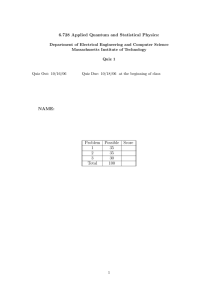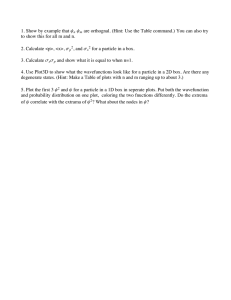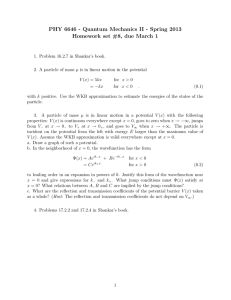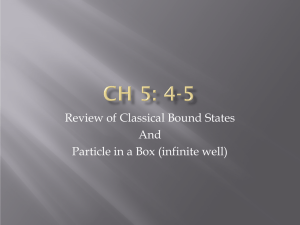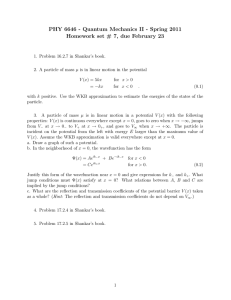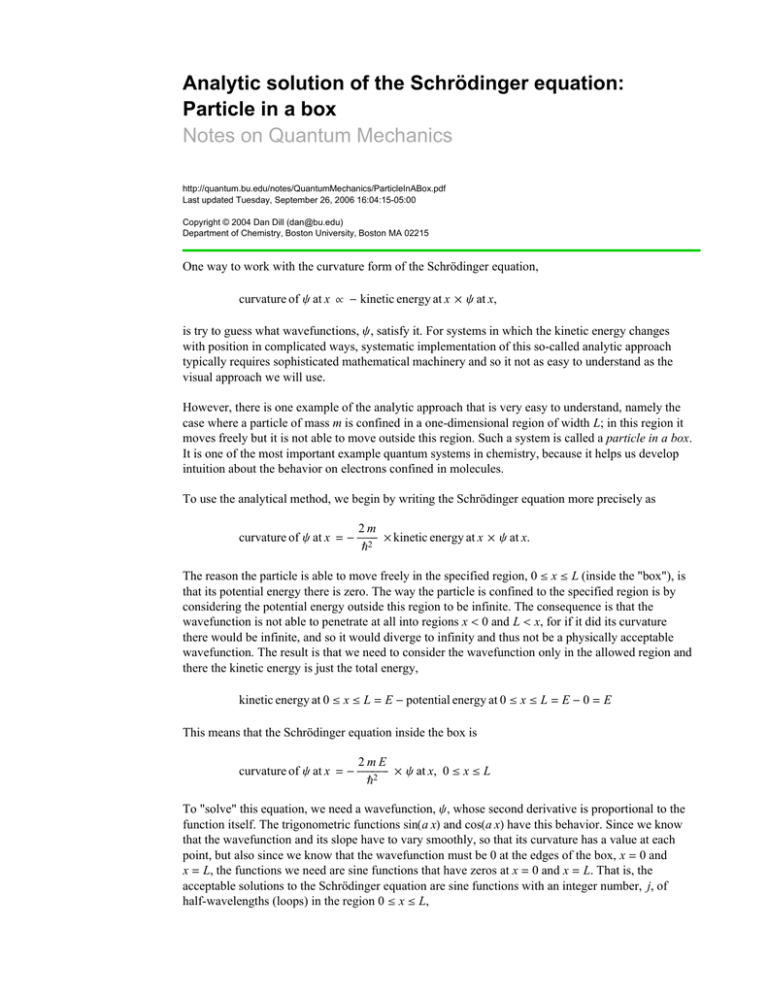
Analytic solution of the Schrödinger equation:
Particle in a box
Notes on Quantum Mechanics
http://quantum.bu.edu/notes/QuantumMechanics/ParticleInABox.pdf
Last updated Tuesday, September 26, 2006 16:04:15-05:00
Copyright © 2004 Dan Dill (dan@bu.edu)
Department of Chemistry, Boston University, Boston MA 02215
One way to work with the curvature form of the Schrödinger equation,
curvature of y at x ∂ - kinetic energy at x μ y at x,
is try to guess what wavefunctions, y, satisfy it. For systems in which the kinetic energy changes
with position in complicated ways, systematic implementation of this so-called analytic approach
typically requires sophisticated mathematical machinery and so it not as easy to understand as the
visual approach we will use.
However, there is one example of the analytic approach that is very easy to understand, namely the
case where a particle of mass m is confined in a one-dimensional region of width L; in this region it
moves freely but it is not able to move outside this region. Such a system is called a particle in a box.
It is one of the most important example quantum systems in chemistry, because it helps us develop
intuition about the behavior on electrons confined in molecules.
To use the analytical method, we begin by writing the Schrödinger equation more precisely as
2m
curvature of y at x = - ÅÅÅÅÅÅÅÅ2ÅÅÅÅ μ kinetic energy at x μ y at x.
Ñ
The reason the particle is able to move freely in the specified region, 0 § x § L (inside the "box"), is
that its potential energy there is zero. The way the particle is confined to the specified region is by
considering the potential energy outside this region to be infinite. The consequence is that the
wavefunction is not able to penetrate at all into regions x < 0 and L < x, for if it did its curvature
there would be infinite, and so it would diverge to infinity and thus not be a physically acceptable
wavefunction. The result is that we need to consider the wavefunction only in the allowed region and
there the kinetic energy is just the total energy,
kinetic energy at 0 § x § L = E - potential energy at 0 § x § L = E - 0 = E
This means that the Schrödinger equation inside the box is
2mE
curvature of y at x = - ÅÅÅÅÅÅÅÅÅÅÅÅ2ÅÅÅÅÅÅ μ y at x, 0 § x § L
Ñ
To "solve" this equation, we need a wavefunction, y, whose second derivative is proportional to the
function itself. The trigonometric functions sinHa xL and cosHa xL have this behavior. Since we know
that the wavefunction and its slope have to vary smoothly, so that its curvature has a value at each
point, but also since we know that the wavefunction must be 0 at the edges of the box, x = 0 and
x = L, the functions we need are sine functions that have zeros at x = 0 and x = L. That is, the
acceptable solutions to the Schrödinger equation are sine functions with an integer number, j, of
half-wavelengths (loops) in the region 0 § x § L,
2
Analytic solution of the Schrödinger equation: Particle in a box
yj =
è!!!!!!!!!
2 ê L sinH j p x ê LL
Here are the functions for j = 1, 2, and 3:
yj
1
0.5
xêL
0.2
0.4
0.6
0.8
1
-0.5
-1
è!!!!!!!!!
2 ê L insures that the probability of finding the particle somewhere in the box is 1,
Normalized wavefunctions for a particle in a box of width L, with one, two and three loops.
The factor
‡
0
L
» y j HxL »2 „ x = ‡
0
L
2
x 2
ÅÅÅÅÅÅ SinJ j p ÅÅÅÅÅÅ N „ x = 1,
L
L
that is, that the wavefunction is normalized.
Once we have the wavefunctions, we can use them in the Schrödinger equation to determine the
corresponding energies. To do this we need to use the expression for the curvature of a sine function
(discussed in the notes on calculus),
curvature of y j at x
è!!!!!!!!! „2
2 ê L ÅÅÅÅÅÅÅÅÅÅÅÅ2Å sinH j p x ê LL
„x
è!!!!!!!!! j p „
= 2 ê L ÅÅÅÅÅÅÅÅÅÅ ÅÅÅÅÅÅÅÅÅÅ cosH j p x ê LL
L „x
2
è!!!!!!!!! j p
= - 2 ê L J ÅÅÅÅÅÅÅÅÅÅ N sinH j p x ê LL
L
2
jp
= -J ÅÅÅÅÅÅÅÅÅÅ N μ y j at x
L
=
Substituting this expression in the Schrödinger equation gives,
2 m Ej
jp 2
ÅÅÅÅÅ μ y at x, 0 § x § L,
curvature of y at x = -J ÅÅÅÅÅÅÅÅÅÅ N μ y j at x = - ÅÅÅÅÅÅÅÅÅÅÅÅÅÅÅÅ
L
Ñ2
and so that
j p 2 2 m Ej
ÅÅÅÅÅ .
J ÅÅÅÅÅÅÅÅÅÅ N = ÅÅÅÅÅÅÅÅÅÅÅÅÅÅÅÅ
L
Ñ2
This result means that the energy of the particle described by the j-th wavefunction in the box is
Copyright © 2004 Dan Dill (dan@bu.edu). All rights reserved
Analytic solution of the Schrödinger equation: Particle in a box
j 2 p2 Ñ2
j 2 p2 Hh ê 2 pL
j 2 h2
E j = ÅÅÅÅÅÅÅÅÅÅÅÅÅÅÅÅÅÅÅÅ2ÅÅÅÅÅ = ÅÅÅÅÅÅÅÅÅÅÅÅÅÅÅÅÅÅÅÅÅÅÅÅÅÅÅÅÅÅÅÅ
ÅÅÅÅ
Å
ÅÅÅ
Å
=
ÅÅÅÅÅÅÅÅ
ÅÅÅÅÅÅÅÅÅÅÅÅÅ .
2mL
2 m L2
8 m L2
2
The key aspects of this result are that the energy increases quadratically with the number of loops in
the wavefunction; it decreases quadratically with the width of the confinement; and it decreases in
proportion to the mass of the particle.
Derive the same energy expression by using de Broglie's relation, p = h ê l, together with
the fact that inside the box the energy of the particle is entirely kinetic, that is, inside the
box, E = p2 ê 2 m.
à Modelling dye-molecule absorption
To get some experience with these results, let's use them to estimate the properties on an electron
confined in a molecule. Here is an expression for the wavelength, in nm, of light corresponding to
the lowest energy transition, j = 1 Ø j Ø 2, of an electron confined in a one-dimensional region of
length L,
hc
8 c m L2
l1Ø2 = ÅÅÅÅÅÅÅÅÅÅÅÅÅÅÅÅÅÅÅÅÅ = ÅÅÅÅÅÅÅÅÅÅÅÅÅÅÅÅÅÅÅÅÅÅÅÅÅ .
DE1Ø2
3h
Show that this expression is correct.
The reason carrots are orange is that the carotene molecules that they contain absorb light in the blue
region of the visible spectrum. Since carotene, C40 H56 , is a long hydrocarbon chain, one way to think
about its absorption of blue light is to consider it as being due to an electron confined as a particle in
a box about the length of the molecule.
Calculate the width of the box, in Þ = 1 μ 10-10 m, that would correspond to an electron
absorbing blue light, 450 nm, in the transition from y1 to y2 . Answer: 6.7 Þ.
à Zero-point energy
One very important result of this analysis is that the lowest energy a particle can have in a one
dimensional box is not zero, but instead
h2
E1 = ÅÅÅÅÅÅÅÅÅÅÅÅÅÅÅÅÅ2ÅÅÅÅ .
8mL
This lowest energy is called the zero-point energy. The reason the zero point energy is always
present is that the wavefunction must always have some curvature in some places, and so there must
always be some kinetic energy. All quantum systems have zero point energy.
Calculate the zero point energy due to the electron assumed to account for carotene
absorption of blue light for a mole of carotene molecules. Answer: 80 kJ.
à Two- and three-dimensional confinement
It is easy to extend the model of a particle confined to two- and three-dimensional regions. The
Schrödinger equation in two dimension is
Copyright © 2004 Dan Dill (dan@bu.edu). All rights reserved
3
4
Analytic solution of the Schrödinger equation: Particle in a box
curvature along x of y at Hx, yL + curvature along y of y at Hx, yL
2m
= - ÅÅÅÅÅÅÅÅ2ÅÅÅÅ μ kinetic energy at position Hx, yL μ y at Hx, yL,
Ñ
and it has a similar expression for three dimensions. As long as the kinetic energy along each
dimension is not affected by the position in the other dimensions, then the Schrödinger equation is
said to be separable, What this means is that then the ratio of the curvature and the wavefunction in
each dimension is constant for all positions.
Here is a way to see that this is so, for the example of confinement in a two dimensional region,
0 § x § Lx , 0 § y § L y , by infinite potential energy at the edges of the regions but with zero potential
energy inside the regions. Since everywhere inside the region the particle has zero potential energy,
this means that its kinetic energy is just the total energy and so is constant. We can thus write the
Schrödinger equation in two dimension for this case a little more simply as
∑2 y Hx, yL
2m
∑2 y Hx, yL
+
ÅÅÅÅÅÅÅÅÅÅÅÅÅÅÅÅÅÅÅÅÅÅÅÅ
Å
ÅÅÅ
Å
Å
ÅÅÅÅÅÅÅÅÅÅÅÅÅÅÅÅ
ÅÅÅÅÅÅÅÅ
ÅÅÅÅÅÅ = - ÅÅÅÅÅÅÅÅ2ÅÅÅÅ E y Hx, yL.
2
2
Ñ
∑x
∑y
To separate motion in x and y we try expressing the wavefunction as a product of wavefunctions for
each dimension,
yHx, yL = X HxL Y HyL.
With this assumed factoring of the overall wavefunction we can write the Schrödinger equation as
1 ∑2 Y HyL
2m
1 ∑2 X HxL
+
ÅÅÅÅÅÅÅÅ
ÅÅÅÅÅÅ ÅÅÅÅÅÅÅÅÅÅÅÅÅÅÅÅ
ÅÅÅÅ
Å
Å
ÅÅÅÅÅÅ = - ÅÅÅÅÅÅÅÅ2ÅÅÅÅ E.
ÅÅÅÅÅÅÅÅÅÅÅÅÅÅÅÅ ÅÅÅÅÅÅÅÅÅÅÅÅÅÅÅÅ
2
2
Y HyL ∑ y
Ñ
X HxL ∑ x
Use the assumed factorization to obtain this equation.
Now, the right hand side of this equation, for a given total (kinetic) energy is a number with units
length-2 .
Show that this dimensional analysis is correct.
For the sake of discussion, let's assume the right hand side evaluates to -0.517 Þ-2 , and that at
x = 0.3 Lx and y = 0.7 L y the terms on the left hand side evaluate to
ij 1 ∑2 Y HyL yz
ij 1 ∑2 X HxL yz
-2
j ÅÅÅÅÅÅÅÅÅÅÅÅÅÅ ÅÅÅÅÅÅÅÅÅÅÅÅÅÅÅÅÅÅÅÅÅÅ z
j ÅÅÅÅÅÅÅÅÅÅÅÅÅÅÅÅ ÅÅÅÅÅÅÅÅÅÅÅÅÅÅÅÅÅÅÅÅÅÅ z
=
0.411
Þ
and
= 0.106 Þ-2 ,
k Y HyL ∑ y2 { y=0.7 Ly
k X HxL ∑ x2 {x=0.3 Lx
so that in terms of numercial values the Schrödinger equation at Hx, yL = H0.3 Lx , 0.7 L y L is
-0.411 Þ-2 - 0.106 Þ-2 = -0.517 Þ-2 .
Next, consider the value of 1 ê X HxL ∑2 X HxL ê ∑ x2 at another value of x, say x = 0.4 Lx ? Let's say the
new value is -q Þ2 ,
ij 1 ∑2 X HxL yz
j ÅÅÅÅÅÅÅÅÅÅÅÅÅÅÅÅ ÅÅÅÅÅÅÅÅÅÅÅÅÅÅÅÅÅÅÅÅÅÅ z
= -q Þ-2 .
k X HxL ∑ x2 {x=0.4 Lx
Since we have not changed the value of y, in terms of numercial values the Schrödinger equation at
Hx, yL = H0.4 Lx , 0.7 L y ) is
-q Þ-2 - 0.106 Þ-2 = -0.517 Þ-2 .
Copyright © 2004 Dan Dill (dan@bu.edu). All rights reserved
Analytic solution of the Schrödinger equation: Particle in a box
Now, the only way this can be true is if q = 0.411. That is, we have the remarkable result that the
value of 1 ê X HxL ∑2 X HxL ê ∑ x2 does not change when x is changed—it is a constant! In a similar way
we can see that 1 ê Y HyL ∑2 Y HyL ê ∑ y2 is a constant too. The net result is that in this way we are able to
separate
1 ∑2 Y HyL
2m
1 ∑2 X HxL
+
ÅÅÅÅÅÅÅÅ
ÅÅÅÅÅÅ ÅÅÅÅÅÅÅÅÅÅÅÅÅÅÅÅÅÅÅÅÅÅ = - ÅÅÅÅÅÅÅÅ2ÅÅÅÅ E.
ÅÅÅÅ
Å
Å
ÅÅÅÅÅÅÅÅÅÅÅÅÅÅÅÅ ÅÅÅÅÅÅÅÅÅÅÅÅÅÅÅÅ
Y HyL ∑ y2
Ñ
X HxL ∑ x2
into two equations,
2m
1 ∑2 X HxL
ÅÅÅÅÅÅ = - ÅÅÅÅÅÅÅÅ2ÅÅÅÅ Ex .
ÅÅÅÅÅÅÅÅÅÅÅÅÅÅÅÅ ÅÅÅÅÅÅÅÅÅÅÅÅÅÅÅÅ
2
Ñ
X HxL ∑ x
2m
1 ∑2 Y HyL
ÅÅÅÅÅÅÅÅÅÅÅÅÅÅ ÅÅÅÅÅÅÅÅÅÅÅÅÅÅÅÅ
ÅÅÅÅÅÅ = - ÅÅÅÅÅÅÅÅ2ÅÅÅÅ E y .
2
Ñ
Y HyL ∑ y
where Ex and E y evidently are the contribution along each dimension to the total energy. This is a
general result:
Whenever the wavefunction can be factored into a product of wavefunctions for separate
dimensions, the energy is the sum of energies for this dimensions.
For the two dimensional particle in a box, this means the wavefunctions are
4
ÅÅÅÅÅÅÅÅÅÅÅÅ%Å%%%%%
ÅÅÅÅÅ sinH j p x ê Lx L sinHk p y ê L y L,
yHx, yL j,k = $%%%%%%%%
Lx L y
the energies are
j 2 h2
k 2 h2
h2
E j,k = ÅÅÅÅÅÅÅÅÅÅÅÅÅÅÅÅÅÅÅÅ2ÅÅÅ + ÅÅÅÅÅÅÅÅÅÅÅÅÅÅÅÅÅÅÅÅ2ÅÅÅ = ÅÅÅÅÅÅÅÅÅÅÅÅÅ
8m
8 m Lx
8 m Lx
ij j 2
k2 y
jj ÅÅÅÅÅÅÅÅÅÅÅÅ + ÅÅÅÅÅÅÅÅÅÅÅÅ zzz,
j 2
z
Ly2 {
k Lx
and the zero point energy is
h2 i 1
1 y
E1,1 = ÅÅÅÅÅÅÅÅÅÅÅÅÅ jjjj ÅÅÅÅÅÅÅÅ2ÅÅÅÅ + ÅÅÅÅÅÅÅÅÅ2ÅÅÅ zzzz.
8 m k Lx
Ly {
Write down the analogous expressions for a particle confined in three dimensions by
infinite potential energy walls for zero potential energy inside the region.
Here is a surface plot of the lowest energy wavefunction,
Copyright © 2004 Dan Dill (dan@bu.edu). All rights reserved
5
6
Analytic solution of the Schrödinger equation: Particle in a box
2
yj,k
1.5
1
1
0.75
0.5
0
0.5
0
yêL
0.25
0.25
0.5
xêL
0.75
1
0
Lowest energy wavefunction of a particle confined to a square, two-dimensional region.
and here is a plot of a higher energy wavefunction.
2
yj,k
1
1
0
-1
0.75
-2
0.5
0
yêL
0.25
0.25
0.5
xêL
0.75
1
0
High energy wavefunction of a particle confined to a square, two-dimensional region.
Assume that the two surfaces are for an electron confined in a benzene ring, approximated
as a two dimensional square of side 4 Þ.. Calculate the wavelength of light needed to cause
the electron wavefunction to change from the first, lowest-energy surface to the second,
higher-energy surface. Answer: 50 nm. What region of the electromagnetic spectrum is
this light?
Copyright © 2004 Dan Dill (dan@bu.edu). All rights reserved
Analytic solution of the Schrödinger equation: Particle in a box
7
Calculate the wavelength of light needed to cause the electron wavefunction to change
from its lowest-energy surface to the surface consisting of one loop in one dimension and
two loops in the other dimension. Answer: 200 nm. What region of the electromagnetic
spectrum is this light?
This wavelength calculated in the previous problem is the longest wavelength light that
such an electron can absorb. Based on this, what color do you expect benzene to be?
Calculate the zero point energy of free motion if one mole of H2 molecules confined in a
container at STP. Assume the zero point energy is due to each molecule moving as a
particle confined in a three dimensional box the size of the container. Answer: 4 μ 10-19 kJ.
Why is the zero point energy of one mole of hydrogen molecules confined at STP so much
less than the zero point energy of electrons confined in one mole of carotene molecules?
Copyright © 2004 Dan Dill (dan@bu.edu). All rights reserved

